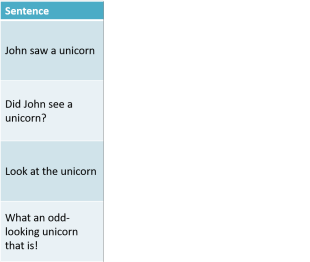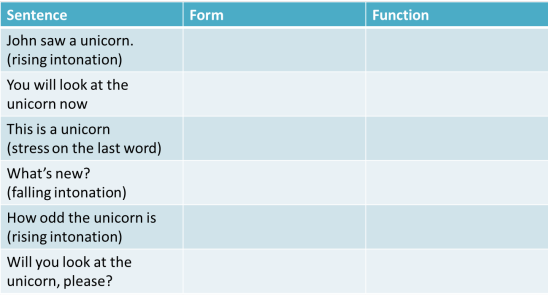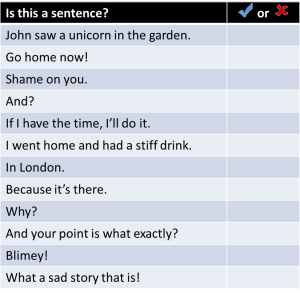Types of sentences
 joining phrases and clauses |
At some point, all approaches to English grammar take the sentence as a basic unit of language. But there's a problem:
 |
What is a sentence? |
Of the following, which, to you, constitute a sentence?
Click on the table when you have looked at each one and decided whether
it is a sentence in English.
Whether you had the same answers or not doesn't matter at this stage.
Look again and decide for yourself what the criteria are to get a tick
in the box. There are two essential criteria.
Click here when you have decided what they are.
- A sentence must contain a finite verb (that is a verb with a tense or person marker)
- A sentence must contain a subject (usually a noun) which governs the verb
There's an exception to Rule 2 in the table. What is it?
Right. The sentence Go home now! gets a tick in the box but has no obvious subject. The subject of imperatives like this is usually implied in English. In many languages the sentence would be You go home now! and it can be expressed that way in English for more emphasis on the subject.
Many grammars will use the term 'clause' instead of 'sentence'. We have analysed clauses separately in this course but individual clauses sometimes are full sentences as we saw in the section explaining them.
 |
Four types of sentence |
Here are the four types of sentence in English exemplified:
| Sentence type | What it is | Example | Comment |
| Simple | One noun and one (finite) verb | Mary didn't believe him. | This is a finite clause which can stand alone |
| Compound | Two clauses (or more) of equal importance | Mary didn't believe him but John was adamant. | Both parts of a compound sentence can stand alone. Usually, they are joined with something like and, or, but |
| Complex | Two clauses, one of which is subordinate (depends on) the other | Mary didn't believe him although he seemed very sure. | The second part of this is a subordinate clause: it cannot stand alone and retain the same meaning |
| Compound-complex | A combination of compound and complex sentences | Mary didn't believe him although he seemed very sure but I accepted what he said. | These sorts of sentences are sometimes difficult to unpack and occur more in writing than speaking |
 |
What do sentences do? |
| Look, a unicorn! |
Sentences have four fundamental functions in language.
Decide
what the function of each sentence below is and then click on the table
for an answer and some comments.

 |
Unfortunately, ... |
... there's another problem. The sentence type does not always
define its function.
Can you complete the table again, stating what the form and function of
each sentence is?
Click on the table when you have an answer.

There are general rules:
- Any form of sentence can be interrogative with the right intonation. (Some languages rely wholly on intonation and have no question form at all.)
- Offers are usually in the form of imperatives or questions (a phenomenon common to many languages) so we can have, e.g., Would you like a drink? or Have a drink etc.
- Statements are frequently used as imperatives so we can have You left the door open meaning Please close the door.
- Interrogative forms can make positive or negative statements so we can have Do you ever listen? meaning You aren't listening and You're driving, are you? meaning You are obviously driving.
- Tag questions such as She's managing the office, isn't she? can function as real questions when the intonation rises and as simple positive statements when it falls.
 |
Negatives |
Can you make two types of negative sentences from this positive one?
Click here when you have noted them down.
She saw a unicorn.
- She didn't see a unicorn. This is a negative statement.
- Didn't she see a unicorn? This is a negative question.
We can also make negative commands, of course, as in Don't look at the unicorn.
 |
Interrogatives |
Can you make four different question forms from the same sentence (She
saw a unicorn)?
Click here when you have a list.
- Closed questions:
Did she see a unicorn?
This is a simple yes/no question, sometimes called a closed question. It may also evince the answer I don't know., of course. - Tag questions:
She saw a unicorn, didn't she? (positive statement + negative tag).
Intonation usually rises if this is a question rather than a statement asking for confirmation.
She didn't see a unicorn, did she? (negative statement + positive tag).
Again, intonation usually rises if this is a question rather than a statement asking for confirmation.
She saw a unicorn, did she? (positive statement + positive tag).
Depending on the intonation, this can express some form of threat or incredulity. - Alternative questions:
Did she see a unicorn or was I hearing things?
This sort of question is nearly always formed with or. - wh-questions:
Who saw a unicorn?
Where did she see a unicorn?
When did she see a unicorn?
Why did she see a unicorn?
Notice that the last one of these questions requires a more elaborate answer than the others.
The word How is also considered a wh-word even though it does not start with the same letters so
How did she react to the unicorn
is also a wh-question.
 |
Learn more about: |
 |
Take a test |
To make sure you have understood so far, try
a very short test of your knowledge of sentences.
Use the 'Back' button to return when you have done that.
If you got that all right, it is safe to move on.
The next part of this section considers how conjunction works in English. Click here to go on.

